Decision Making Process and Problem Solving Models Analysis
VerifiedAdded on 2021/04/17
|6
|1452
|194
Report
AI Summary
This report examines the decision-making process and various problem-solving models used in business contexts. It begins by introducing the problem-solving model and its importance in identifying and addressing organizational issues, emphasizing the need for systematic approaches to navigate uncertainties and risks. The report then explores the application of these models, highlighting their role in identifying potential threats and ensuring organizational sustainability. Several problem-solving models are discussed, including the brainstorming model, mind maps, the 5 Whys technique, fishbone diagrams, De Bono's Six Thinking Hats, and the 8D model. The report further focuses on three key models: the brainstorming model for generating innovative ideas, the five whys analysis for identifying root causes, and the fishbone model for understanding cause-and-effect relationships. The report uses the case of Super Food Market to illustrate how these models can be applied to improve product quality, address taste issues, and enhance customer loyalty. The analysis underscores the importance of these models for effective decision-making and problem-solving in business environments.

Running head: DECISION MAKING PROCESS
DECISION MAKING PROCESS
Name of the student
Name of the university
Author note
DECISION MAKING PROCESS
Name of the student
Name of the university
Author note
Paraphrase This Document
Need a fresh take? Get an instant paraphrase of this document with our AI Paraphraser
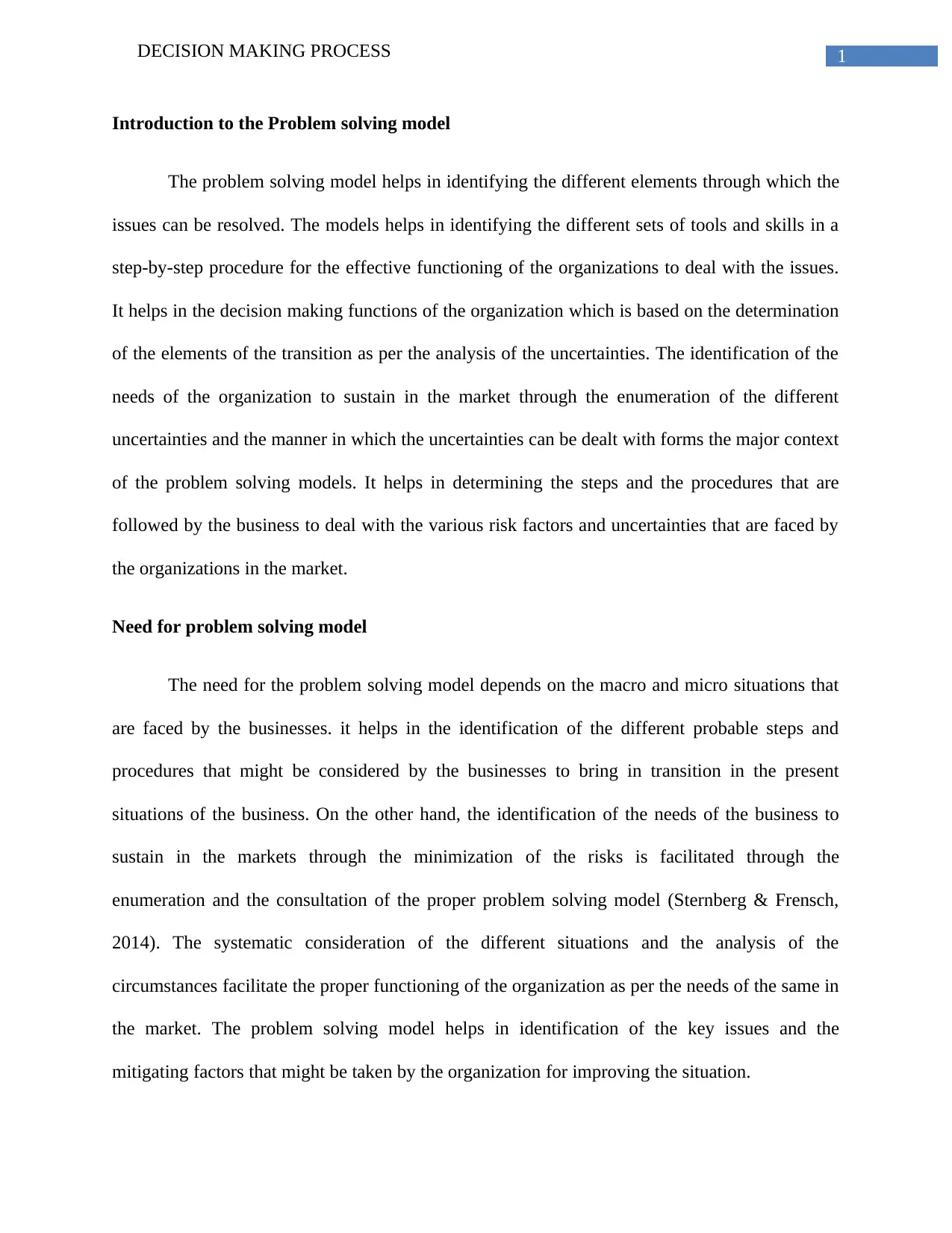
1DECISION MAKING PROCESS
Introduction to the Problem solving model
The problem solving model helps in identifying the different elements through which the
issues can be resolved. The models helps in identifying the different sets of tools and skills in a
step-by-step procedure for the effective functioning of the organizations to deal with the issues.
It helps in the decision making functions of the organization which is based on the determination
of the elements of the transition as per the analysis of the uncertainties. The identification of the
needs of the organization to sustain in the market through the enumeration of the different
uncertainties and the manner in which the uncertainties can be dealt with forms the major context
of the problem solving models. It helps in determining the steps and the procedures that are
followed by the business to deal with the various risk factors and uncertainties that are faced by
the organizations in the market.
Need for problem solving model
The need for the problem solving model depends on the macro and micro situations that
are faced by the businesses. it helps in the identification of the different probable steps and
procedures that might be considered by the businesses to bring in transition in the present
situations of the business. On the other hand, the identification of the needs of the business to
sustain in the markets through the minimization of the risks is facilitated through the
enumeration and the consultation of the proper problem solving model (Sternberg & Frensch,
2014). The systematic consideration of the different situations and the analysis of the
circumstances facilitate the proper functioning of the organization as per the needs of the same in
the market. The problem solving model helps in identification of the key issues and the
mitigating factors that might be taken by the organization for improving the situation.
Introduction to the Problem solving model
The problem solving model helps in identifying the different elements through which the
issues can be resolved. The models helps in identifying the different sets of tools and skills in a
step-by-step procedure for the effective functioning of the organizations to deal with the issues.
It helps in the decision making functions of the organization which is based on the determination
of the elements of the transition as per the analysis of the uncertainties. The identification of the
needs of the organization to sustain in the market through the enumeration of the different
uncertainties and the manner in which the uncertainties can be dealt with forms the major context
of the problem solving models. It helps in determining the steps and the procedures that are
followed by the business to deal with the various risk factors and uncertainties that are faced by
the organizations in the market.
Need for problem solving model
The need for the problem solving model depends on the macro and micro situations that
are faced by the businesses. it helps in the identification of the different probable steps and
procedures that might be considered by the businesses to bring in transition in the present
situations of the business. On the other hand, the identification of the needs of the business to
sustain in the markets through the minimization of the risks is facilitated through the
enumeration and the consultation of the proper problem solving model (Sternberg & Frensch,
2014). The systematic consideration of the different situations and the analysis of the
circumstances facilitate the proper functioning of the organization as per the needs of the same in
the market. The problem solving model helps in identification of the key issues and the
mitigating factors that might be taken by the organization for improving the situation.
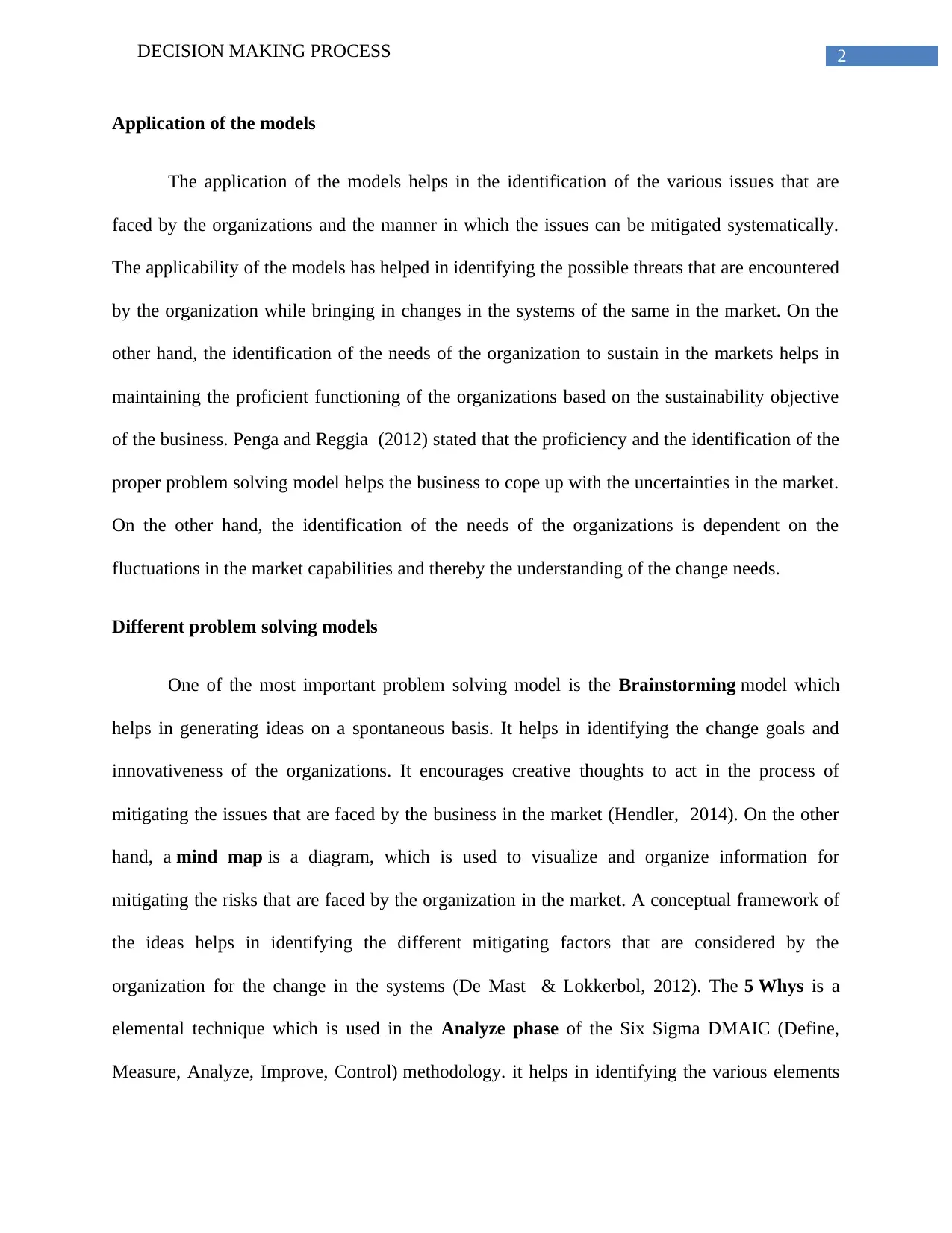
2DECISION MAKING PROCESS
Application of the models
The application of the models helps in the identification of the various issues that are
faced by the organizations and the manner in which the issues can be mitigated systematically.
The applicability of the models has helped in identifying the possible threats that are encountered
by the organization while bringing in changes in the systems of the same in the market. On the
other hand, the identification of the needs of the organization to sustain in the markets helps in
maintaining the proficient functioning of the organizations based on the sustainability objective
of the business. Penga and Reggia (2012) stated that the proficiency and the identification of the
proper problem solving model helps the business to cope up with the uncertainties in the market.
On the other hand, the identification of the needs of the organizations is dependent on the
fluctuations in the market capabilities and thereby the understanding of the change needs.
Different problem solving models
One of the most important problem solving model is the Brainstorming model which
helps in generating ideas on a spontaneous basis. It helps in identifying the change goals and
innovativeness of the organizations. It encourages creative thoughts to act in the process of
mitigating the issues that are faced by the business in the market (Hendler, 2014). On the other
hand, a mind map is a diagram, which is used to visualize and organize information for
mitigating the risks that are faced by the organization in the market. A conceptual framework of
the ideas helps in identifying the different mitigating factors that are considered by the
organization for the change in the systems (De Mast & Lokkerbol, 2012). The 5 Whys is a
elemental technique which is used in the Analyze phase of the Six Sigma DMAIC (Define,
Measure, Analyze, Improve, Control) methodology. it helps in identifying the various elements
Application of the models
The application of the models helps in the identification of the various issues that are
faced by the organizations and the manner in which the issues can be mitigated systematically.
The applicability of the models has helped in identifying the possible threats that are encountered
by the organization while bringing in changes in the systems of the same in the market. On the
other hand, the identification of the needs of the organization to sustain in the markets helps in
maintaining the proficient functioning of the organizations based on the sustainability objective
of the business. Penga and Reggia (2012) stated that the proficiency and the identification of the
proper problem solving model helps the business to cope up with the uncertainties in the market.
On the other hand, the identification of the needs of the organizations is dependent on the
fluctuations in the market capabilities and thereby the understanding of the change needs.
Different problem solving models
One of the most important problem solving model is the Brainstorming model which
helps in generating ideas on a spontaneous basis. It helps in identifying the change goals and
innovativeness of the organizations. It encourages creative thoughts to act in the process of
mitigating the issues that are faced by the business in the market (Hendler, 2014). On the other
hand, a mind map is a diagram, which is used to visualize and organize information for
mitigating the risks that are faced by the organization in the market. A conceptual framework of
the ideas helps in identifying the different mitigating factors that are considered by the
organization for the change in the systems (De Mast & Lokkerbol, 2012). The 5 Whys is a
elemental technique which is used in the Analyze phase of the Six Sigma DMAIC (Define,
Measure, Analyze, Improve, Control) methodology. it helps in identifying the various elements
⊘ This is a preview!⊘
Do you want full access?
Subscribe today to unlock all pages.

Trusted by 1+ million students worldwide
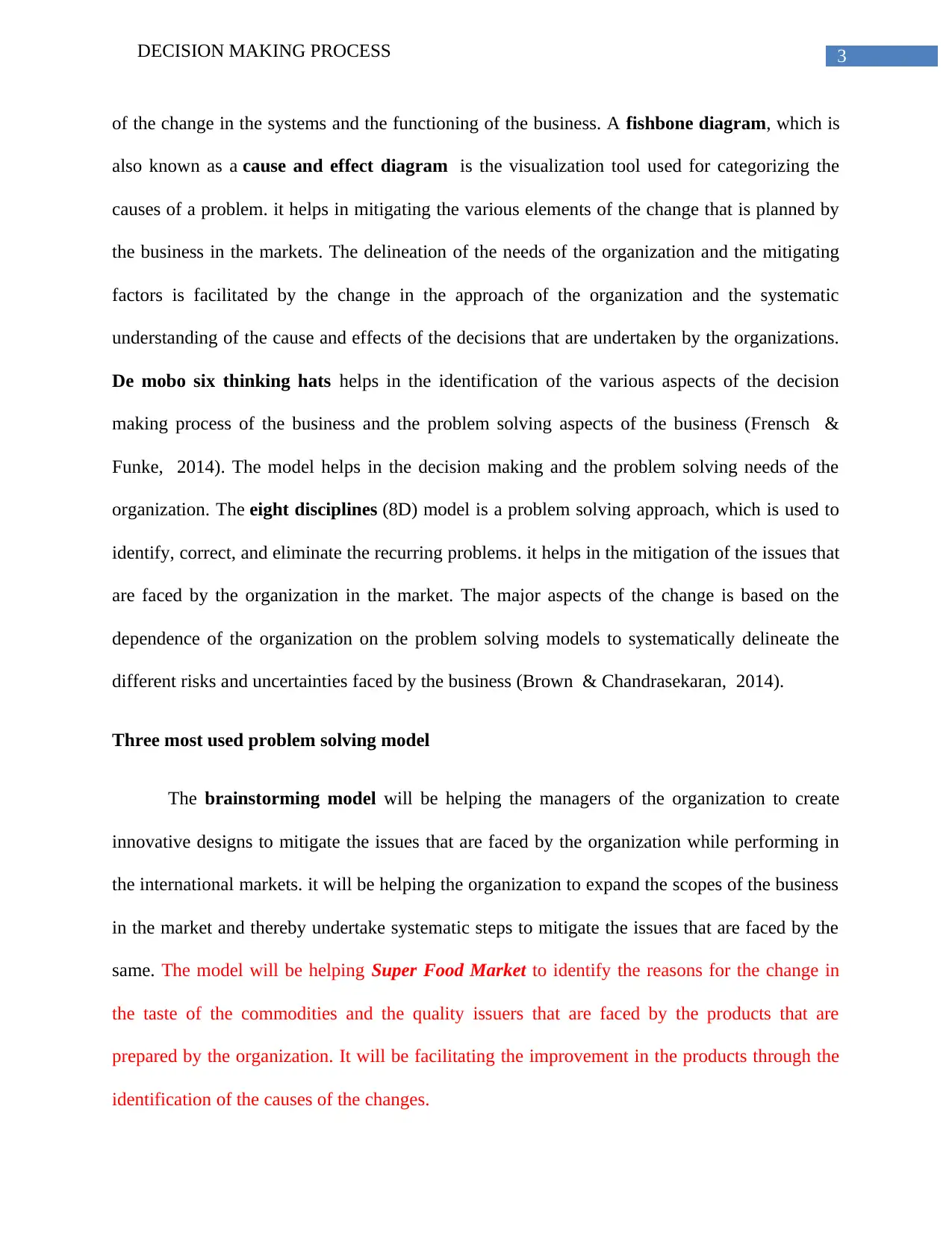
3DECISION MAKING PROCESS
of the change in the systems and the functioning of the business. A fishbone diagram, which is
also known as a cause and effect diagram is the visualization tool used for categorizing the
causes of a problem. it helps in mitigating the various elements of the change that is planned by
the business in the markets. The delineation of the needs of the organization and the mitigating
factors is facilitated by the change in the approach of the organization and the systematic
understanding of the cause and effects of the decisions that are undertaken by the organizations.
De mobo six thinking hats helps in the identification of the various aspects of the decision
making process of the business and the problem solving aspects of the business (Frensch &
Funke, 2014). The model helps in the decision making and the problem solving needs of the
organization. The eight disciplines (8D) model is a problem solving approach, which is used to
identify, correct, and eliminate the recurring problems. it helps in the mitigation of the issues that
are faced by the organization in the market. The major aspects of the change is based on the
dependence of the organization on the problem solving models to systematically delineate the
different risks and uncertainties faced by the business (Brown & Chandrasekaran, 2014).
Three most used problem solving model
The brainstorming model will be helping the managers of the organization to create
innovative designs to mitigate the issues that are faced by the organization while performing in
the international markets. it will be helping the organization to expand the scopes of the business
in the market and thereby undertake systematic steps to mitigate the issues that are faced by the
same. The model will be helping Super Food Market to identify the reasons for the change in
the taste of the commodities and the quality issuers that are faced by the products that are
prepared by the organization. It will be facilitating the improvement in the products through the
identification of the causes of the changes.
of the change in the systems and the functioning of the business. A fishbone diagram, which is
also known as a cause and effect diagram is the visualization tool used for categorizing the
causes of a problem. it helps in mitigating the various elements of the change that is planned by
the business in the markets. The delineation of the needs of the organization and the mitigating
factors is facilitated by the change in the approach of the organization and the systematic
understanding of the cause and effects of the decisions that are undertaken by the organizations.
De mobo six thinking hats helps in the identification of the various aspects of the decision
making process of the business and the problem solving aspects of the business (Frensch &
Funke, 2014). The model helps in the decision making and the problem solving needs of the
organization. The eight disciplines (8D) model is a problem solving approach, which is used to
identify, correct, and eliminate the recurring problems. it helps in the mitigation of the issues that
are faced by the organization in the market. The major aspects of the change is based on the
dependence of the organization on the problem solving models to systematically delineate the
different risks and uncertainties faced by the business (Brown & Chandrasekaran, 2014).
Three most used problem solving model
The brainstorming model will be helping the managers of the organization to create
innovative designs to mitigate the issues that are faced by the organization while performing in
the international markets. it will be helping the organization to expand the scopes of the business
in the market and thereby undertake systematic steps to mitigate the issues that are faced by the
same. The model will be helping Super Food Market to identify the reasons for the change in
the taste of the commodities and the quality issuers that are faced by the products that are
prepared by the organization. It will be facilitating the improvement in the products through the
identification of the causes of the changes.
Paraphrase This Document
Need a fresh take? Get an instant paraphrase of this document with our AI Paraphraser
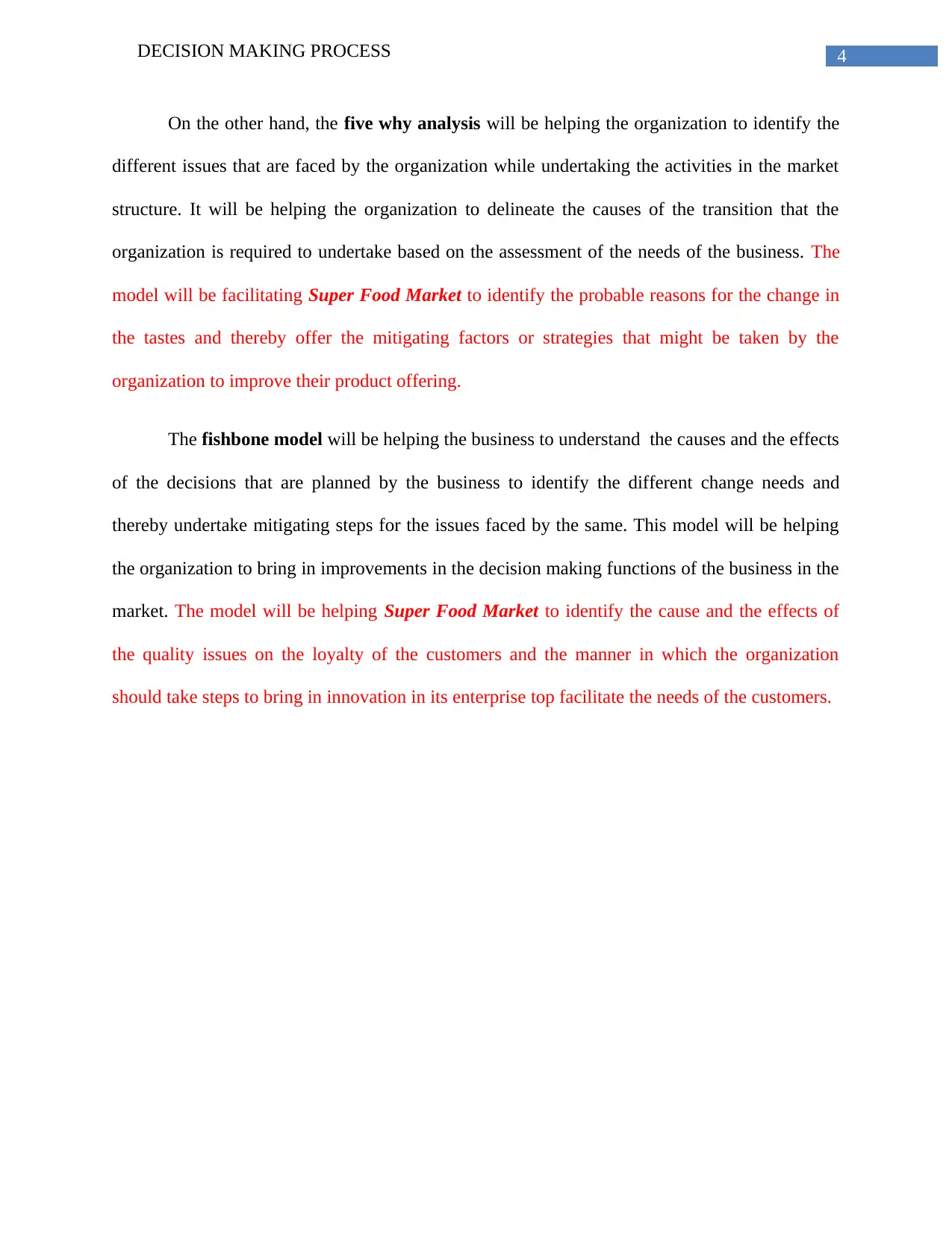
4DECISION MAKING PROCESS
On the other hand, the five why analysis will be helping the organization to identify the
different issues that are faced by the organization while undertaking the activities in the market
structure. It will be helping the organization to delineate the causes of the transition that the
organization is required to undertake based on the assessment of the needs of the business. The
model will be facilitating Super Food Market to identify the probable reasons for the change in
the tastes and thereby offer the mitigating factors or strategies that might be taken by the
organization to improve their product offering.
The fishbone model will be helping the business to understand the causes and the effects
of the decisions that are planned by the business to identify the different change needs and
thereby undertake mitigating steps for the issues faced by the same. This model will be helping
the organization to bring in improvements in the decision making functions of the business in the
market. The model will be helping Super Food Market to identify the cause and the effects of
the quality issues on the loyalty of the customers and the manner in which the organization
should take steps to bring in innovation in its enterprise top facilitate the needs of the customers.
On the other hand, the five why analysis will be helping the organization to identify the
different issues that are faced by the organization while undertaking the activities in the market
structure. It will be helping the organization to delineate the causes of the transition that the
organization is required to undertake based on the assessment of the needs of the business. The
model will be facilitating Super Food Market to identify the probable reasons for the change in
the tastes and thereby offer the mitigating factors or strategies that might be taken by the
organization to improve their product offering.
The fishbone model will be helping the business to understand the causes and the effects
of the decisions that are planned by the business to identify the different change needs and
thereby undertake mitigating steps for the issues faced by the same. This model will be helping
the organization to bring in improvements in the decision making functions of the business in the
market. The model will be helping Super Food Market to identify the cause and the effects of
the quality issues on the loyalty of the customers and the manner in which the organization
should take steps to bring in innovation in its enterprise top facilitate the needs of the customers.
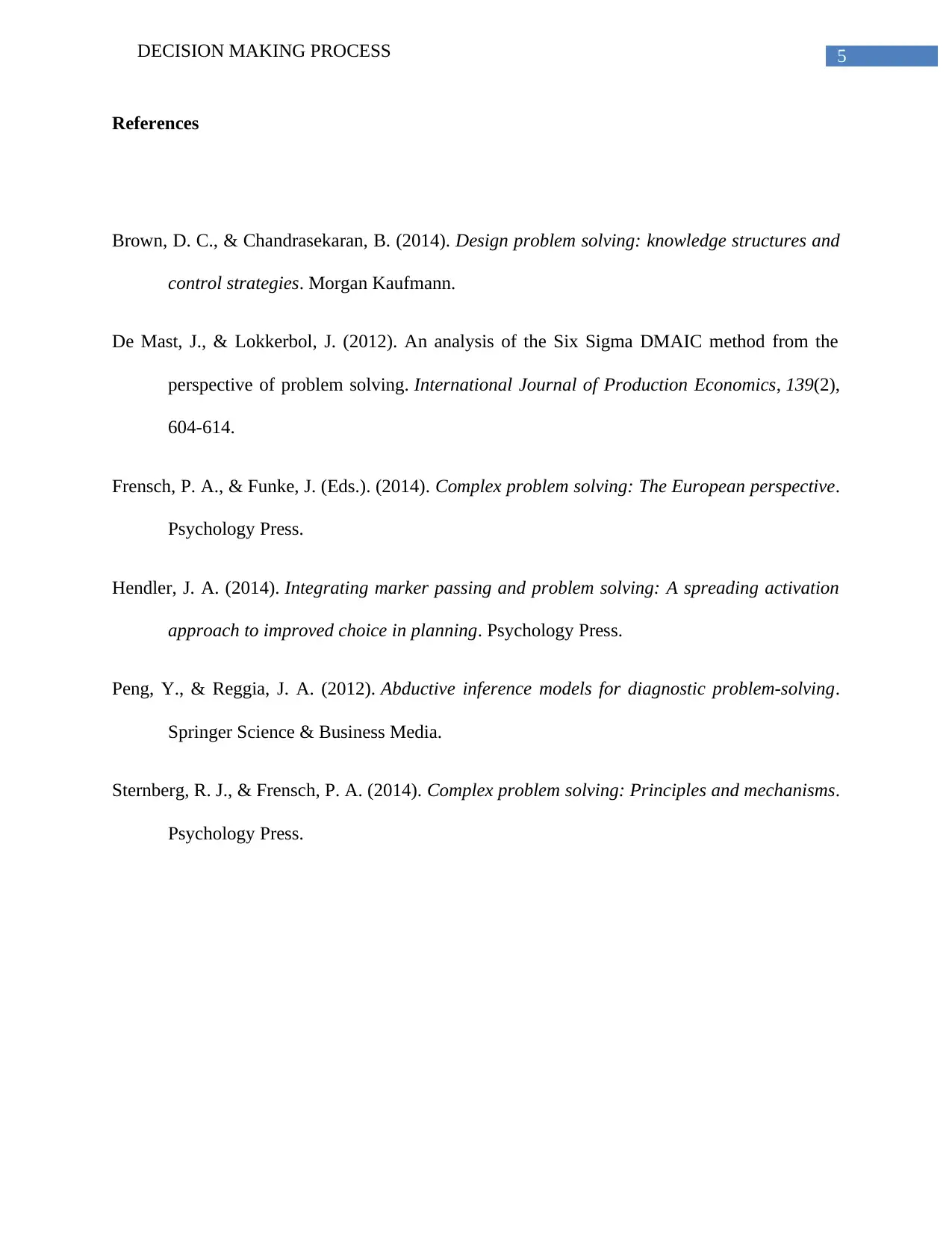
5DECISION MAKING PROCESS
References
Brown, D. C., & Chandrasekaran, B. (2014). Design problem solving: knowledge structures and
control strategies. Morgan Kaufmann.
De Mast, J., & Lokkerbol, J. (2012). An analysis of the Six Sigma DMAIC method from the
perspective of problem solving. International Journal of Production Economics, 139(2),
604-614.
Frensch, P. A., & Funke, J. (Eds.). (2014). Complex problem solving: The European perspective.
Psychology Press.
Hendler, J. A. (2014). Integrating marker passing and problem solving: A spreading activation
approach to improved choice in planning. Psychology Press.
Peng, Y., & Reggia, J. A. (2012). Abductive inference models for diagnostic problem-solving.
Springer Science & Business Media.
Sternberg, R. J., & Frensch, P. A. (2014). Complex problem solving: Principles and mechanisms.
Psychology Press.
References
Brown, D. C., & Chandrasekaran, B. (2014). Design problem solving: knowledge structures and
control strategies. Morgan Kaufmann.
De Mast, J., & Lokkerbol, J. (2012). An analysis of the Six Sigma DMAIC method from the
perspective of problem solving. International Journal of Production Economics, 139(2),
604-614.
Frensch, P. A., & Funke, J. (Eds.). (2014). Complex problem solving: The European perspective.
Psychology Press.
Hendler, J. A. (2014). Integrating marker passing and problem solving: A spreading activation
approach to improved choice in planning. Psychology Press.
Peng, Y., & Reggia, J. A. (2012). Abductive inference models for diagnostic problem-solving.
Springer Science & Business Media.
Sternberg, R. J., & Frensch, P. A. (2014). Complex problem solving: Principles and mechanisms.
Psychology Press.
⊘ This is a preview!⊘
Do you want full access?
Subscribe today to unlock all pages.

Trusted by 1+ million students worldwide
1 out of 6
Related Documents
Your All-in-One AI-Powered Toolkit for Academic Success.
+13062052269
info@desklib.com
Available 24*7 on WhatsApp / Email
![[object Object]](/_next/static/media/star-bottom.7253800d.svg)
Unlock your academic potential
Copyright © 2020–2025 A2Z Services. All Rights Reserved. Developed and managed by ZUCOL.





